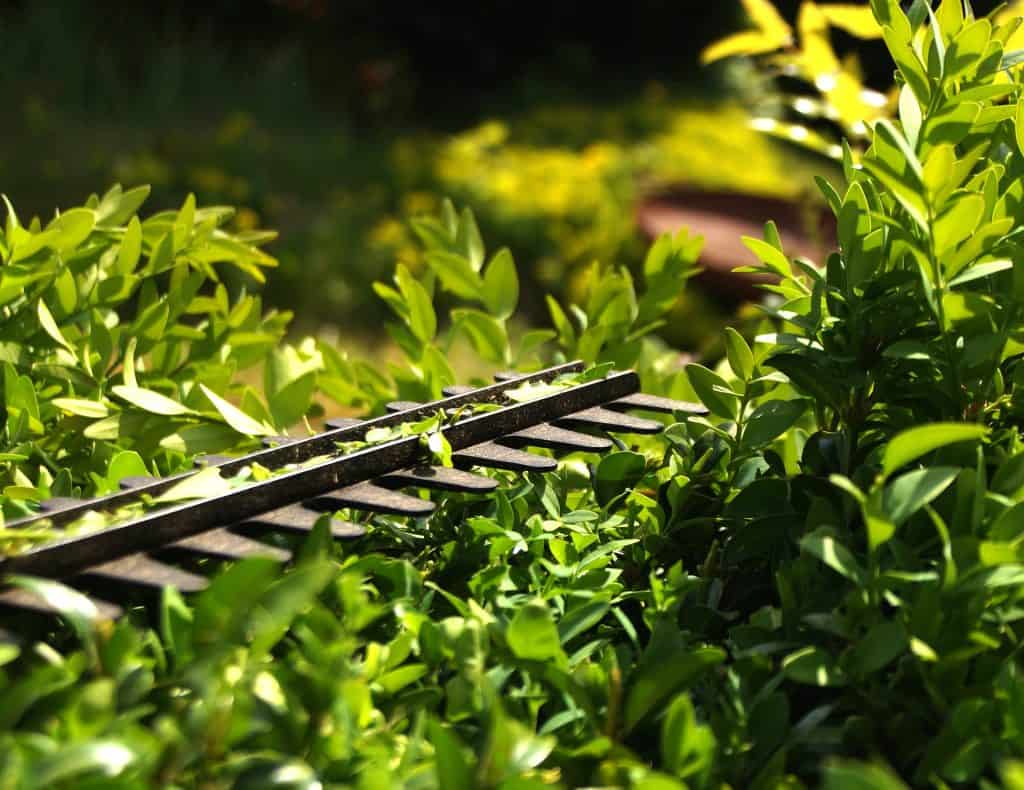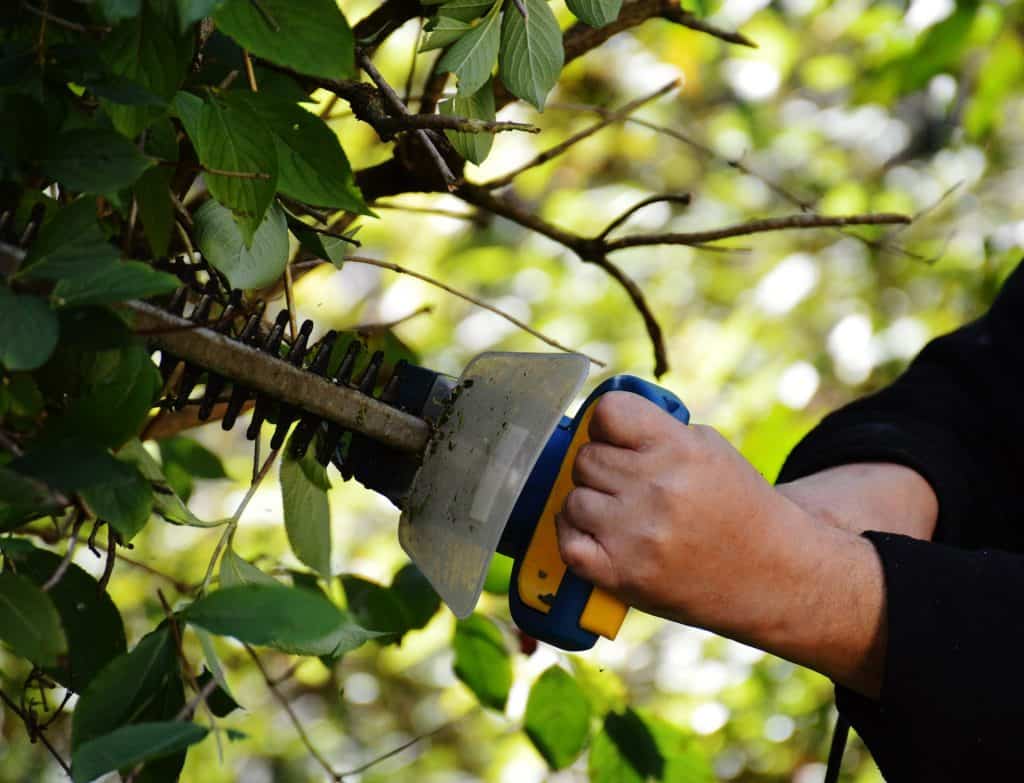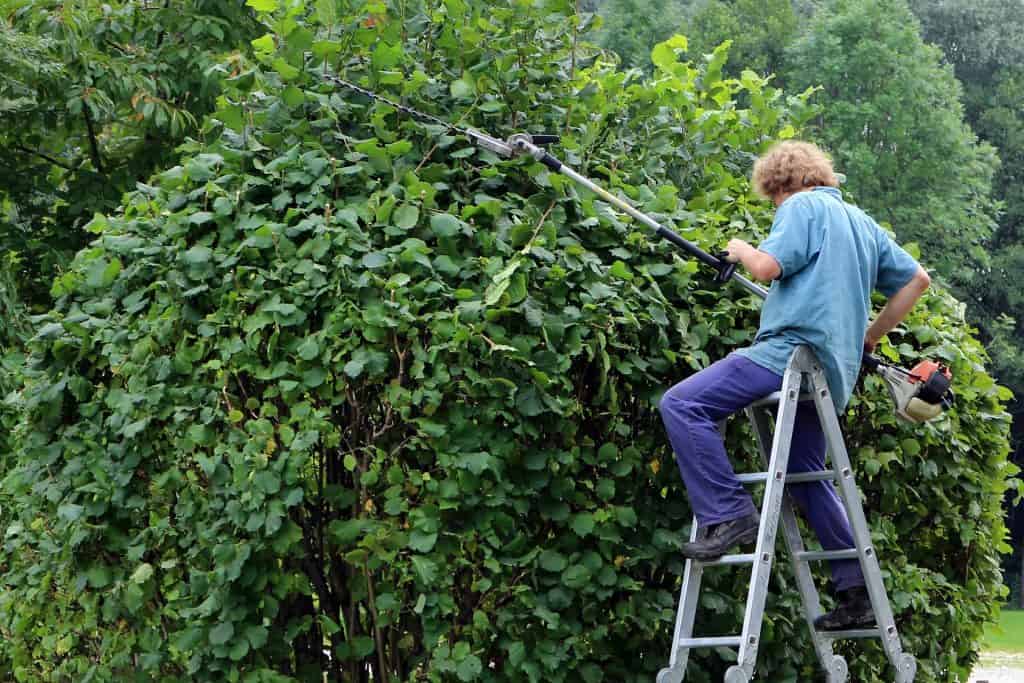Hedges and bushes around the house add lovely touches to landscaping, as well as privacy and security. When they start to get overgrown, however, they can change from a great addition into a visual nightmare.
There are plenty of landscaping services out there that can clean them up for you, but knowing how to use a hedge trimmer can save you a ton of money each year.
How to Use a Hedge Trimmer
The long, straight construction of hedge trimmers is meant to create flat, even cuts on a bush, shrub, or hedge. They are not meant for tree cutting or any maintenance on hard old wood growth, and should only be used on soft, non-woody new growth at the ends of stems.
Used correctly, they will keep your yard looking great and promote even growth of your hedges.
Preparing to Cut Hedges
The first step is to make sure your hedge trimmer is lubricated. You can use any normal tool oil, or WD40 can work in a pinch. For a product with a sprayer, simply spray it along the length of the blade, getting into the high-friction areas along the spine.

With oil products, dribble a bit into the spine over the entire blade, and wipe down with a shop rag.
Consider laying down sheeting or a tarp underneath the hedges and area that is being trimmed to save time when cleaning up afterward. This is especially useful when cutting over grass, as raking up the trimmings will be a lot harder than picking them up with a sheet.
Hedge Trimmer Safety
Safety is important. A hedge trimmer is a fast moving tool and can cause personal damage if precautions are not taken. We recommend the following:
- Gloves – You will be holding close to the blade and hedge, gloves will help prevent scratches or cuts from cut debris.
- Eye protection – With the fast back and forth action of the trimmer blade, debris can jump back at you. Protect your eyes.
- Boots – Even though you should be cutting only light, new growth, a lot of trimmings will fall on your feet. There is also the possibility of dropping the hedge trimmer. If you don’t have boots, at the very least wear close-toed shoes.
- Ear protection – Not completely necessary when using an electric hedge trimmer, but very recommended when using gas-powered tools.
- Hold the blade of the trimmer away from you – It seems silly to have to say it, but always hold the blade end of the trimmer facing away from your body. When trimming hedges you may find yourself in a situation where moving the blade towards you seems like the easiest option, but if you rotate yourself around to the other side, it will probably be safer.
- Never use a ladder to get to hard-to reach places – For taller hedges, consider buying or renting a long reach hedge trimmer, or an attachment that extends the reach.
How to Use a Hedge Trimmer
Start off by looking at your hedge, and determining the size, angles, and amount of material you want to cut.
Cut Front Face of the Hedge

The first areas you should use your hedge trimmer on are the vertical faces, and make sure the front is cut first.
Using a short, flat motion, start at the bottom of the hedge and work your way up, finishing at the top. Only trim a little bit off at a time. It may seem more efficient to use a wide sweeping motion to get the job done more quickly, but this carries the chance of bending your angles halfway through the stroke.
Hold your line the entire way through to create a flat, even face.
For the shape, you will want the bottom of the hedge to be wider, and the top slightly more narrow. This will allow for more sunlight to reach the bottom branches as well as forming a stronger base that can hold the weight of the hedge.
Repeat for the other sides.
Cut Top of Hedge
The top of the hedge should be even and flat on a horizontal plane. Use a side to side motion, and again, trim small amounts
For smaller hedges, it should be fairly easy to cut a flat edge across the top without aid. Larger hedges, on the other hand, will require some sort of marker to keep your edges true.
To set your cutting angle, set up two stakes on the sides (or front and back) of the hedge, and tie a taut nylon rope between them at the height you want to trim to. Fishing line works well for this.
Make sure there is no sagging, and use a level to make sure the line is flat against the horizon. Trim to just above the line, making sure not to snag and cut your line in the process.
Clear Away Hedge Trimmings

If you used a tarp or ground cover, simply pick up the cut branches and debris with the tarp. Otherwise, sweep, rake, or pick up the debris. Place where you would normally dispose of lawn trimmings.
Many cities have garden refuse collection, but be sure to check their guidelines for what can and cannot be picked up.
Examine Inside of Hedge
One the exterior edges are trimmed, it is much easier to take a look at the inner branch system. You may find additional cut branches on the inside of the bush, be sure to remove those. Look for dead, damaged, or diseased branches on the interior of the hedge.
If you find any, remove with [amazon link=”B075QP897Z” title=”hand pruners” /] or a [amazon link=”B01E5NQ2U4″ title=”tree trimmer” /].
Hedge Trimming Tips
- Only use hedge trimmers on soft, new growth of 3/4″ diameter or less. Lower power trimmers may not be able to handle even that width, so check the user manual.
- Let the trimmer do the work. If you run into a branch or tough area that the trimmer has trouble cutting, check the blades for sharpness or stuck debris. If your hedge trimmer is new or has recently had maintenance done on it, that area may be too strong. Switch to hand pruners or a small saw to get through those dense areas.
- For new growth, use a side to side sweeping action.
- On old growth, it may help to use a forward and back sawing action.
- An easy way to give your hedges a finished look is to taper or bevel the hedge a little near the top. This is sometimes less difficult than cutting exact square corners.
Types of Hedge Trimmers
There are a few different types of hedge trimmers available. Deciding on which to purchase is usually going to depend on a combination of your needs and your budget.

Gas Powered Hedge Trimmers
Hedge trimmers with a combustion engine and gas tank are normally the most powerful trimmers available. In a professional maintenance setting, these will often be the tool of choice.
The cost is generally higher than electric trimmers, but the consistent cuts and quality of construction are worth the price.
Gas trimmers have a long life span as long as you know how to maintain a 2 cycle engine. The oil to gas ratio needs to be correctly managed, and problems like clogged carburetors can be a nuisance but aren’t extremely hard to fix.
Be sure to only use fresh fuel, do not let gas sit in the tank for extended periods of time.
The weight of a gas powered hedge trimmer is usually heavier than its electric counterparts.
Corded Electric Hedge Trimmers
The ease of an electric motor makes the electric hedge trimmer an excellent choice for home use. If you are willing to spend a little more, there are excellent trimmers with high RPM engines that can just about reach the cutting power of a gas trimmer.
The main drawback of corded electric trimmers is the cord. You need to be sure that the cord will reach every area that you need to get to, and in some outside settings this can be problematic.
Be sure to have a highly rated [amazon link=”B00OS7ETIA” title=”extension cord” /] on hand, especially if the existing cord length just barely reaches your last shrub.

Another drawback with the cord is the safety ramifications. Always be sure that the cord is behind you, and far away from the blade of the hedge trimmer. When moving around the hedge you are cutting, keep an eye out for the cord so you do not trip over it.
Cordless Hedge Trimmers
For a tradeoff between the portability of a gas powered trimmer and the virtually maintenance-free corded electric trimmer, battery powered hedge trimmers may be a good choice. They are lightweight, you don’t have to worry about the cord getting in your way, and you don’t need to deal with maintaining the engine.
Unfortunately, the batteries do not last as long as a tank of gas on engine-based trimmers, and they often do not reach the power level of their corded counterparts. It is a good idea to keep an extra battery or two charged when trimming a large area.
In addition, the batteries can wear out over time, lowering power and cutting down the amount of time that they can run.
Conclusion
Using a hedge trimmer is fairly easy once you try it a time or two. When first starting out, cut short amounts off the ends of the bushes to get a feel for the tool. Once you are comfortable, cut to the length desired.
Your hedges will be cleaned up and looking good in no time.